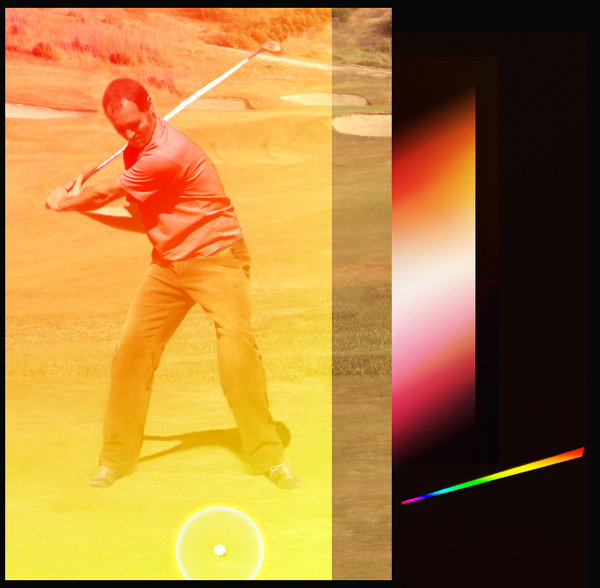


| Author | Methodology | Gallery |
| Credentials | Insights | Instruction |
| Blog | Students | Contact |
.............................................................
|
ADVANCED BALL STRIKING ONLINE TRAINING COURSE (student area) PHYSICS One thing we can be certain of is that you don't need a physics degree to be champion golfer. Of the years I spent on tour, I never once met a tour player who had a degree in mechanical or motion physics. For our purposes here, we do need to understand a few basics, nothing complicated, but since the golf swing is dealing with forces, let's look at a few things, and most importantly how these forces feel in the body. For our class, we'll keep this very simple Velocity = the speed something travels (without change) Acceleration = an increasing change in velocity Deceleration = a decrease in velocity Momentum = defines a moving mass or ..p= m x v (p being momentum) Force: f = m x a (force equals mass times acceleration) We can increase our force by both increasing the mass of the club, and or, the acceleration of that mass. We can consider force to be an increasing momentum. The important thing to understand, is that the compression of a golf ball is both dependent upon pre and post impact clubhead speeds. In other words, the less the clubhead slows down due to the forces of the impact collision, the more the ball is compressed. The more we compress the ball, the longer it stays on the clubface. We learn to play golf by feeling impact, so this compression is very important to us as golfers. Our feel is enhanced, and our ability to maneuver the golf ball becomes more empowering to us as we learn to increase our feel and ball compression. Centrifugal Force: We hear this a lot in golf, basically speaking, centrifugal force is the force we feel as the golf club wants to move away from our body. We feel this on the backswing, and on the downswing. The club wants to accelerate away from us... as we rotate... in either direction. The heavier the club, the more centrifugal force, the faster we rotate, the more centrifugal force. (assuming the weight does not slow down our rotation, it may or it may not, obviously at some point it will, and we will need to look at that later on) Centripetal Force: This is the force that we experience as we change direction at the top of our backswing and move into the downswing. Centripetal Force is that force which moves TOWARDS the center. The change in direction compresses the clubshaft in and towards our body, very briefly, but we need to understand that this happens. As the body turns toward the ball, at some point the inertia and angular momentum of the golf club take over, and this centripetal force magically becomes centrifugal force once again. There is a transfer of power, of force, and this energy shoots down into the clubshaft and into the clubhead. We feel "the out" then "the in" then "the out". Nothing complicated. Longitudinal Acceleration For our purposes here, we will use longitudinal acceleration to describe the action of the clubshaft. The concept of the shaft itself wanting to expand "telescopically" in length is an important concept for golf. This is at the core of what we will refer to as hitting vs swinging. A limp rope or string magically has a firmness to it when cracked like a whip. It also has a firmness to it while spinning in a circle. This added structure to a normally limp object is what we are talking about here. Longitudinal acceleration creates an added structure and support to our golf shaft to aid in resisting the forces of impact. The object of the swinger's game is to "time" the straightening of the shaft right at the exact low point of the golf swing. If done correctly it can and does work very well. For most, it is NOT done correctly, and that is why you are here reading this article and considering... if you haven't already.... signing up for this class. Radial Acceleration Radial acceleration in conjunction with tangential acceleration, creates for us an opportunity to "bend" the shaft backwards, and create a "pre stressed" clubshaft as we go into the impact arena. We will use the term radial because it is more commonly used in books such as "The Golfing Machine" and other more scientific golf related books. Let's think of this as acceleration moving around or following the arc of the circle, not in an "inline" motion stretching the shaft lengthwise. What we refer to as "hitters" are using this type of acceleration as their primary intent and protocol. The hitter strives to bring into impact a pre stressed "loaded" shaft into impact. This takes acceleration through the ball, not just at the ball. The Difference Let's think of this as "cracking a whip" vs. driving a hammer. They can both hurt... but as we will learn, hitting offers a greater potential to compress a golf ball. This IS the first secret of golf. At some point I'll probably add more scientific research here for the more "brainiac" students. However, the bottom line is, the motion of the body has a much better chance to create desirable impact physics than an "armchair" study of physics has at creating a desirable motion of the body.... leading to great impact physics. |
.................................................................................................................